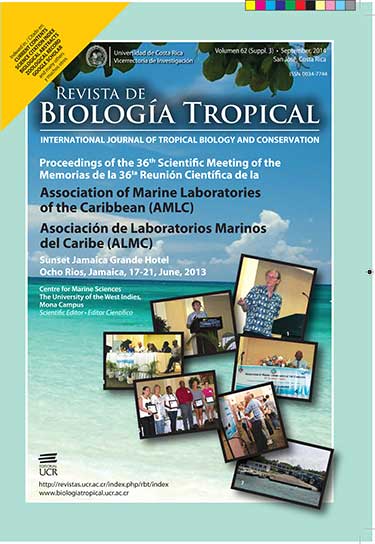Resumen
El caracol rosa Strombus gigas tiene importancia pesquera en el Caribe, cuyas poblaciones se encuentran sobreexplotadas. Desde la década de 1980 se han desarrollado estudios de acuacultura, manejo del recurso y rehabilitación de áreas con la finalidad de proteger e incrementar sus poblaciones. Sin embargo, poco se sabe sobre el comportamiento del caracol rosa en su medio natural y la influencia de los parámetros ambientales. Mensualmente de enero a noviembre de 2012 en la caleta de Xel Há se observaron y cuantificaron seis comportamientos de S. gigas: reposo, alimentación, movimiento, cópula, enterrados y desove. Las observaciones se realizaron cada hora de 8h a 17h por medio de buceo libre en tres transectos con tres repeticiones cada uno. Cada comportamiento fue observado 90 veces cada mes. Se registraron datos de salinidad, temperatura y oxígeno disuelto en el fondo. El comportamiento anual de S. gigas presentó el mayor número de caracoles en reposo en julio. La alimentación y el movimiento tuvieron un máximo en agosto. La mayoría de caracoles enterrados se encontró en octubre y noviembre. La cópula comenzó a observarse en marzo con un máximo en junio y el desove de julio a octubre. En las observaciones diurnas e independientemente de los meses, el reposo tuvo un pico a las 8h, alimentación a las 12 y movimiento a las 17h. La cópula y el desove no presentaron un patrón en su comportamiento. Existieron variaciones significativas entre meses y horas (reposo, alimentación, movimiento y enterrado) (p<0.05). El reposo se correlacionó con la temperatura y los enterrados con el oxígeno (r=-0.5803; p=0.0536). La alimentación con temperatura, salinidad y oxígeno. El movimiento con temperatura y salinidad. Estos resultados son útiles para programas de conservación, restauración y cultivo de la especie.
Citas
Aldana, D., & Brulé, T. (1994). Estado Actual de la pesquería, del cultivo y programa de investigación del caracol Strombus gigas en México. En Appeldoorn, R. S., & Rodríguez, Q. B. (eds). Queen Conch Biology, Fisheries and Mariculture. Caracas, Venezuela: Fundación Científica Los Roques.
Aldana, D. (2006). Overview del patrón reproductivo del caracol Strombus gigas para diferentes localidades del Caribe. 57th Gulf and Caribbean Fisheries Institutes, 771-790.
Aldana, D., Sánchez, M., Reynaga, P., Patiño, V., George, A., & Baqueiro, E. R. (2005). Crecimiento y temporada reproductiva del caracol rosado Strombus gigas en el Parque Xel-Há, México. 56th Gulf and Caribbean Fisheries Institutes, 742-754.
Brownell, W. N., & Stevely, J. M. (1981). The biology, fisheries, and management of the queen conch, Strombus gigas. Marine Fisheries Review, 43(07), 1-12.
CITES-Convention of International Trade in Endangered Species of Wild Fauna and Flora. (2003). Review of significant trade in specimens of Appendix II species. 19th Meeting of the Animals Committee, Geneva Switzerland.
Davis, M. (2005). Species Profile Queen conch Strombus gigas. SRAC Publication No. 7203.
Davis, M., Hesse C., & Hodgkins, G. (1987). Commercial hatchery produced queen conch, Strombus gigas, seed for the research and grow-out market. Proceedings of the Gulf and Caribbean Fisheries Institutes, 38, 326-335.
De Santis, C. (1982). Algunos aspectos de la ecología trófica del Botuto (Strombus gigas) con miras a su cultivo en el Archipiélago de los Roques, Venezuela. Tesis de Licenciatura. Universidad Central de Venezuela. Caracas, Venezuela.
FAO. (2007). Report on the Regional Workshop on the monitoring and management of Queen Conch, Strombus gigas. Kingston, Jamaica: FAO Fisheries Report No. 832.
Hesse, K. O. (1979) Movement and migration of the queen conch, Strombus gigas, in Turks and Caicos Islands. Bulletin of Marine Science, 29(3), 303-311.
Orr, K. S., & Berg, C. J. Jr. (1987). The Queen Conch. Miami, USA: Finney Company Incorporated.
Peel, J. R., Saenz, R., May, E., Montero, J., & Aldana-Aranda, D. (2010). Importance of a Marine Protected Area in the Mexican Caribbean on the Conservation of the Endangered Species of Queen Conch, Strombus gigas. GCFI Book of Abstracts, 63, 39.
Perez, M., & Aldana, D. (2003). Actividad reproductiva de Strombus gigas (Mesogasteropoda: Strombidae) en diferentes hábitats del Arrecife Alacranes, Yucatán. Revista de Biología Tropical Suplemento, 4, 119-126.
Randall, J. E. (1964). Contributions to the biology of the “queen conch” Strombus gigas. Bulletin of Marine Science of the Gulf and Caribbean, 14, 246-295.
Stoner, A. W., & Sandt, V. J. (1992). Population structure, seasonal movements and feeding of queen conch, Strombus gigas in deep-water habitats of the Bahamas. Bulletin of Marine Science, 51(3), 287-300.
Stoner, A. W., & Ray-Culp, M. (2000). Evidence for Allee effects in an over-harvested marine gastropod: density-dependent mating and egg production. Marine Ecology Progress Series, 202, 297-302.
Fig. 1. Variaciones mensuales del comportamiento de S. gigas: a) reposo, b) alimentación, c) movimiento, d) enterrados, e) cópula y f) Desove. *diferencia significativa, n=90.
Fig. 1. Monthly behavior of queen conch S. gigas: a) resting, b) feeding, c) moving, d) buried, e) copulating, f) spawning. *Significant difference, n=90.
##plugins.facebook.comentarios##

Esta obra está bajo una licencia internacional Creative Commons Atribución 4.0.
Derechos de autor 2014 Revista de Biología Tropical


